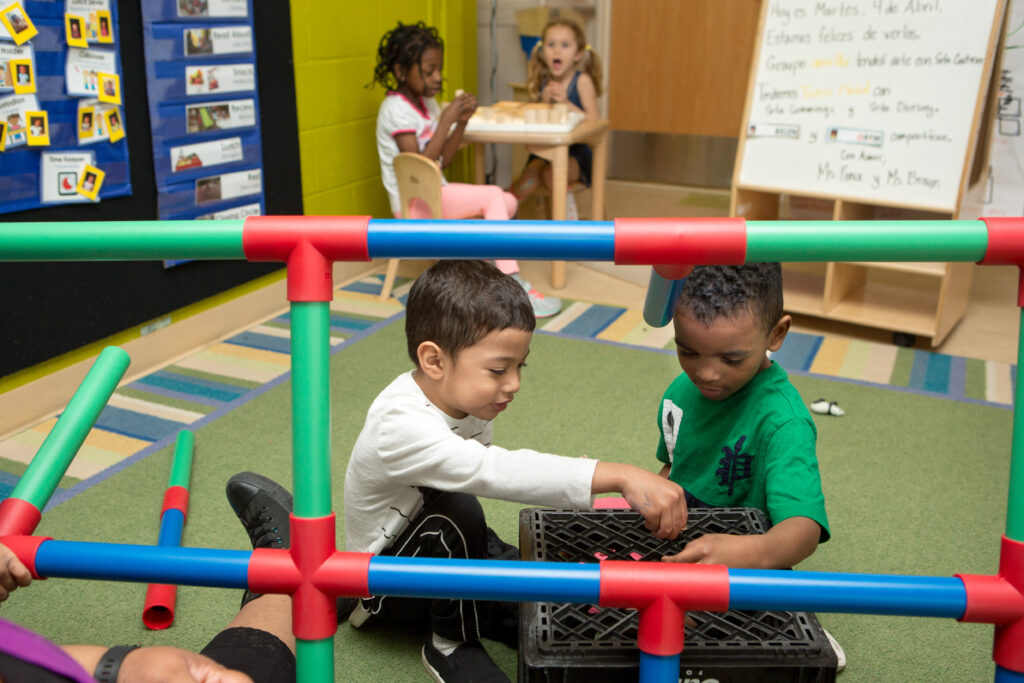key takeaway
California is expanding Transitional Kindergarten to all four-year-old children by 2025-26, supported by state investments to improve access, staffing, and equity in public preschool programs.
Early learning is foundational for young children’s development, and preschool programs provide essential opportunities for 3- and 4-year-olds. Recognizing this, in 2021, California policymakers embarked on a significant expansion of Transitional Kindergarten (TK), a specialized preschool program for 4-year-old children offered at public schools. This ambitious expansion is backed by substantial state investment, reflecting a commitment to broaden access to preschool education. To support the multi-year plan, the state has allocated billions of dollars in one-time and ongoing funding. Through these investments, TK will be universally available to all four-year-old children in California by the 2025-26 school year.
How Policy Decisions Shaped the Expansion of Transitional Kindergarten
The TK program has been in place since 2012.1Senate Bill 1381 (Simitian, Chapter 705, Statutes of 2010), https://leginfo.legislature.ca.gov/faces/billTextClient.xhtml?bill_id=200920100SB1381 Its original purpose was to provide preschool education for four-year-old children who, based on the month they were born, were no longer eligible to enroll in kindergarten after the state adjusted the age cutoff for kindergarten admission — creating TK also allowed school districts to continue claiming Average Daily Attendance (ADA) for these students.2SB 1381 (Simitian) Essentially, this policy change prevented four-year-olds from being admitted to kindergarten if they turned five later in the year after enrolling in kindergarten.3Assembly Committee on Education analysis of Senate Bill 1381 (Simitian), June 1, 2010, https://leginfo.legislature.ca.gov/faces/billAnalysisClient.xhtml?bill_id=200920100SB1381# After a gradual implementation of this policy, during the 2014-15 school year, four-year-old children had to turn five on or before September 1st to be admitted into kindergarten. At the same time, certain four-year-olds no longer eligible for kindergarten were admitted into TK. Specifically, from 2014-15 until 2022-23, four-year-old children were eligible for TK if they had their fifth birthday between September 2nd and December 2nd.
In 2021-22, state leaders initiated another multi-year policy through the state budget to significantly grow the TK program, implementing a five-year plan that gradually increases age eligibility based on the month a child was born.4This expansion is part of a broader initiative, Universal PreKindergarten (UPK), aimed at bringing together preschool programs to ensure all children have access to early learning experiences the year before they start kindergarten. The increase in eligibility is primarily backed by allocating additional funding to school districts to implement the expansion. By the end of the expansion plan, in 2025-26, the program will be open to all four-year-old children who turn four by September 1.
The State Has Invested Billions of Dollars to Support Transitional Kindergarten
To carry out the expansion plan, state leaders agreed to provide the needed resources to initiate the expansion and sustain the program going forward. So far, the state budget has provided a mix of both one-time and ongoing resources. Those are outlined below:
- One-time resources have been allocated to build foundational elements of the program. The state has provided more than $1 billion since 2021-22 in one-time dollars for TK planning and implementation grants, facilities, and efforts to support the preschool teacher workforce — some of this funding was also available to support the California State Preschool Program (CSPP) and kindergarten.
- The state is increasing ongoing funding for TK to accommodate the substantial growth in attendance resulting from the expansion. TK is supported by the Local Control Funding Formula (LCFF), which uses attendance to generate funding allocations to school districts (more details are provided in the “How Proposition 98 and the LCFF Support Transitional Kindergarten” section below). As of 2024-25 the state has provided an estimated $1.4 billion to account for the growth in attendance — this number tends to change when districts update and report their attendance numbers throughout the school year. Under current attendance projections the state would provide an additional $876 million in 2025-26, which would mark full expansion of the program. Attendance projections in prior years have overestimated TK uptake and attendance. Therefore, for 2025-26, the projected funding may be lower than currently proposed once attendance is collected and reported.
- The state is increasing ongoing funding to improve staffing ratios in TK. As shown in the chart, an estimated $517 million has been allocated in 2024-25 to maintain a 1:12 adult-to-student ratio in TK classrooms. The 2025-26 budget proposes an additional $952 million to reduce ratios to 1:10, which would grow to a total of nearly $1.5 billion for this purpose. These dollars help maintain current staffing levels and would bring thousands of additional teachers and instructional aides to TK classrooms.5Districts that fail to meet staffing ratios face penalties that result in loss of funding. There are also penalties for not meeting class size requirements or teacher education requirements.
California has dedicated significant funding to schools to support the expansion of TK, including resources for planning grants, staffing, and attendance growth. This investment has facilitated substantial enrollment growth. However, realizing the full potential of this expansion requires addressing several key challenges. Securing and retaining a qualified TK workforce is essential, as staffing challenges could hinder the program’s effectiveness. Additionally, a continued focus on equitable access and consistent student attendance, particularly among low-income families is crucial. By addressing these key areas, California can maximize the impact of its investments and ensure four-year-olds benefit from this expansion.
Proposition 98 and the Local Control Funding Formula
How do state resources support TK expansion?
TK is funded through the LCFF, the same mechanism that funds K-12 grades. Funding for LCFF originates from Proposition 98, which guarantees a minimum annual funding amount for TK-12 schools and community colleges. The state fulfills this guarantee using General Fund dollars and local property taxes.
To support the growing costs of TK expansion, policymakers have gradually increased the Prop. 98 minimum guarantee. This adjustment, driven by increased student attendance through the LCFF, results in a larger share of state revenue being dedicated to education. This process of adjusting Prop. 98 is commonly known as “rebenching.” The chart below illustrates the year-over-year growth in Prop. 98 since 2022-23 based on current and projected attendance through the 2025-26 fiscal year. The orange bar reflects total growth across 2022-23 to 2025-26.
What is the role of the LCFF in distributing resources to local communities for TK expansion?
The LCFF is the primary funding formula for K-12 school districts, charter schools, and county offices of education. The LCFF is an equity-based formula that provides a base grant per TK-12 student, adjusted to reflect the number of students at various grade levels, as well as additional grants for English learners, students from low-income families, and foster youth.
The LCFF uses an attendance measure, average daily attendance (ADA), to calculate funding. The base grant for TK (and grades K-3) in 2024-25 is $10,025, as shown in the table below, and is adjusted if districts meet average class sizes of 24 students or less. Districts also receive an add-on per TK ADA to maintain class ratios of 1:12 per classroom.
Additionally, the TK-3 base grant — and the base grant for all other grade levels — is “weighted” to provide additional funding to districts that enroll students classified as English learners, are eligible to receive a free or reduced-price meal, or are foster children. The LCFF provides a “supplemental” grant of 20% of the base grant for each of these students. When the number of these high-need students (TK and all other grade levels combined) exceeds 55% of a school district’s enrollment, a “concentration” grant of 65% of the base grant is applied for students above that threshold. These two grants are the key variables that ensure a more equitable distribution of funding to the highest-need districts.


